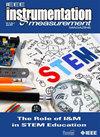Improvement of the Standard Test Method for Effective Series Resistance (ESR) and Capacitance of Ultra High-Q Capacitors at High Frequencies
IF 1.6
4区 工程技术
Q3 ENGINEERING, ELECTRICAL & ELECTRONIC
引用次数: 0
Abstract
Ultra high-Q ceramic chip capacitors exhibit quality factors (Q) higher than 1000. The Resonant Coaxial-Line, manufactured by Boonton [1], has enough resolution for measuring such High-Q factors. As a result, in 1982, the resonant coaxial-line method was standardized by the American Society for Testing and Materials (ASTM) that issued the: “Standard Test Method for Effective Series Resistance (ESR) and Capacitance of Multilayer Ceramic Capacitors at High Frequencies” [2]. Applying this method, we found an error that concerns the measurement of a capacitor serially connected with a resonant coaxial-line and more particularly the frequency extrapolations that are mandatory for taking into account the skin effect [3]. Besides warning a user about an error, this paper is an opportunity to recall the principle of the resonant coaxial-line method and thereafter to present successively: the direct error free frequency extrapolation solution and the more complex procedure of the ASTM [2]. After comparison, the error that plagues the ASTM method is computed and is finally experimentally evaluated. Authors' note: In this paper, the symbols are identical to the ones specified by the ASTM [2].高频超高q电容有效串联电阻(ESR)和电容标准试验方法的改进
超高Q陶瓷片电容器的品质因数(Q)高于1000。Boonton[1]制造的谐振同轴线具有足够的分辨率来测量这种高Q因子。因此,1982年,谐振同轴线法被美国材料试验协会(ASTM)标准化,该协会发布了“多层陶瓷电容器高频有效串联电阻(ESR)和电容的标准测试方法”[2]。应用这种方法,我们发现了一个与谐振同轴线串联的电容器的测量有关的误差,特别是考虑趋肤效应时必须进行的频率外推[3]。除了警告用户错误之外,本文还提供了一个机会来回顾谐振同轴线方法的原理,并随后依次介绍:直接无误差频率外推解决方案和ASTM[2]更复杂的程序。经过比较,计算了困扰ASTM方法的误差,并对其进行了实验评估。作者注:在本文中,符号与ASTM[2]规定的符号相同。
本文章由计算机程序翻译,如有差异,请以英文原文为准。
求助全文
约1分钟内获得全文
求助全文
来源期刊

IEEE Instrumentation & Measurement Magazine
工程技术-工程:电子与电气
CiteScore
4.20
自引率
4.80%
发文量
147
审稿时长
>12 weeks
期刊介绍:
IEEE Instrumentation & Measurement Magazine is a bimonthly publication. It publishes in February, April, June, August, October, and December of each year. The magazine covers a wide variety of topics in instrumentation, measurement, and systems that measure or instrument equipment or other systems. The magazine has the goal of providing readable introductions and overviews of technology in instrumentation and measurement to a wide engineering audience. It does this through articles, tutorials, columns, and departments. Its goal is to cross disciplines to encourage further research and development in instrumentation and measurement.
 求助内容:
求助内容: 应助结果提醒方式:
应助结果提醒方式:


